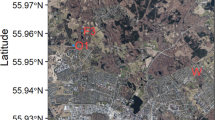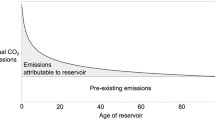Abstract
The fluxes of carbon dioxide were determined at the water–air interface using floating chambers connected to an automated nondispersive infrared instrument (NDIR) or a Fourier transform infrared instrument (FTIR). The fluxes were measured in 2002 over 280 sites in Canadian reservoirs, rivers, and natural lakes. Mean measured emissions of CO2 in old Québec reservoirs (> 10 years) were around 1600 ± 1500 mg CO2/m2/day and around 735 ± 1125 mg CO2/m2/day in natural lakes. In a young Québec reservoir (5 years old), values were higher, with mean measured emissions around 4400 ± 4000 mg CO2/m2/day. In Manitoba, old reservoirs had mean values around 3350 ± 2725 mg CO2/m2/day and natural lakes values around 1365 ± 2375 mg CO2/m2/day. In British Columbia, mean values were around 250 ± 800 and 500 ± 650 mg CO2/m2/day, respectively, for old reservoirs and natural lakes. Our data suggest that water quality and the input of carbon from terrestrial systems affect CO2 fluxes from waterbodies. Our results also show that reservoirs older than 10 years are comparable to natural lakes or rivers in terms of the water quality or gross CO2 fluxes and that higher emissions in young reservoir would last 6–8 years.






Similar content being viewed by others
References
Aronsen, G. S. Sobek, A.-K. Bergstrom, L. Tranvik, A. Agren, and M. Jansson. 2002. The flux of CO2 from boreal lakes in a landscape perspective. Proceedings of the American Society of Limnology and Oceanography, 10–14 June 2002, Victoria, British Columbia.
R Carignan (1998) ArticleTitleAutomated determination of carbon dioxide, oxygen, and nitrogen partial pressures in surface waters. Limnology and Oceanography 43 969–975 Occurrence Handle1:CAS:528:DyaK1cXms1SlsLw%3D
Chartrand, N., R. Schetagne, and R. Verdon. 1994. Enseignements tirés du suivi environnemental au complexe La Grande. Pages 165–190 in Compte-rendus du 18e Congrès de la commission internationale des grands barrages, Paris.
I. D. Clark P. Fritz (1997) Environmental isotopes in hydrology. Lewis Publishers New York 328
J. J. Cole N. F. Caraco (2001) ArticleTitleCarbon in catchments: connecting terrestrial carbon losses with aquatic metabolism. Marine & Freshwater Resources 52 101–110
E. Duchemin M. Lucotte R. Canuel A. Chamberland (1995) ArticleTitleProduction of the greenhouse gases CH4 and CO2 by hydroelectric reservoirs of the boreal region. Global Biogeochemical Cycles 9 529–540 Occurrence Handle10.1029/95GB02202 Occurrence Handle1:CAS:528:DyaK2MXpslCktbw%3D
E. Duchemin M. Lucotte R. Canuel (1999a) ArticleTitleComparison of static chamber and thin boundary layer equation methods for measuring greenhouse gas emissions from large water bodies. Environmental Science and Technology 33 350–357 Occurrence Handle10.1021/es9800840 Occurrence Handle1:CAS:528:DyaK1cXnslCrurc%3D
Duchemin, E., R. Canuel, P. Ferland, and M. Lucotte. 1999b. Étude sur la production et l’émission de gaz à effet de serre par les réservoirs hydroélectriques de l’entreprise et des lacs naturels, Université du Québec à Montréal, Montréal, 47 pp.
P. M. Fearnside (1996) ArticleTitleHydroelectric Dams in Brazilian Amazonia: Response to Rosa, Schaeffer and dos Santos. Environmental Conservation 23 105–108 Occurrence Handle1:CAS:528:DyaK28XntFKgu70%3D
R. O. G. Franken W. Van Vierssen H. J. Lubberding (1992) ArticleTitleEmissions of some greenhouse gases from aquatic and semi-aquatic ecosystems in Netherlands and options to control them. Science of the Total Environment 126 277–293 Occurrence Handle10.1016/0048-9697(92)90202-4 Occurrence Handle1:CAS:528:DyaK38XmsFOlt7c%3D
L. Gagnon J. F. van de Vate (1997) ArticleTitleGreenhouse gas emissions from hydropower: the state of research in 1996. Energy Policy 25 7–13 Occurrence Handle10.1016/S0301-4215(96)00125-5
Guertin, G., M. Lambert, and A. Tremblay. 2002. Development of in situ analysis technique for greenhouse gas samples collected by floating chambers and a hydroplane. Pages 488–497 in Proceedings of Symposium on Reservoir Management in Tropical and Sub-Tropical Regions, International Commission on Large Dams, 22–27 September 2002, Iguaçu, Brazil.
D. Hope T. K. Kratz J. L. Riera (1996) ArticleTitleRelationship between Pco2 and dissolved organic carbon in northern Wisconsin Lakes. Journal of Environmental Quality 25 1442–1445 Occurrence Handle1:CAS:528:DyaK28XnsV2isr0%3D
G. W. Kling G. W. Kipphut M. C. Miller (1992) ArticleTitleThe flux of CO2 and CH4 from lakes and rivers in Arctic Alaska. Hydrobiologia 240 23–36 Occurrence Handle1:CAS:528:DyaK3sXhtFeisw%3D%3D
Kortelainen, P. 1998. Finnish lakes as a source of greenhouse gases: CH4, CO2 and N2O supersaturation in 12 Finnish lakes before and after ice-melt. Pages 41–49 in Proceedings of International Workshop of Hydro Dams, Lakes and Greenhouse Emissions, 4–5 December 1998, Copacabana, Rio de Janeiro.
Lambert, M. 2001. Campagne d’échantillonnage sur les émissions de gaz à effet de serre des réservoirs et des lacs environnants. Rapport de terrain 2000. Hydro-Québec, Montréal, 60 pp.
Lambert, M. 2002. Campagne d’échantillonnage sur les émissions de gaz à effect de serre des réservoirs et des lacs environnants. Rapport de terrain 2001. Hydro-Québec, Montréal, 136 pp.
Lambert, M., J. L Fréchette, P. Dumas, A. Tremblay, and L. Varfalvy. 2001. Development of exsitu GC/MS analysis technique for greenhouse gas samples collected by floating Chambers and a Hydroplane. Proceedings of the 28th congress of the Societas Internationalis Limnologiae, 4–10 February 2001, Melbourne, Australia.
M. Lucotte R. Schetagne N. Thérien C. Langlois A. Tremblay (1999) Mercury in the biogeochemical cycle: natural environments and hydroelectric reservoirs of northern Québec (Canada). Springer-Verlag New York 334
G. A. Makhov N. M. Bazhin (1999) ArticleTitleMethane emission from lakes. Chemosphere 38 1453–1459 Occurrence Handle10.1016/S0045-6535(98)00547-5 Occurrence Handle1:CAS:528:DyaK1MXptVyqsw%3D%3D Occurrence Handle10070731
Martikainen, P. T. Vaisanen, M. Heisnen, A. Niskanen, J. Huttunen, P. Hanninen, S. Hellsten, H Nykanen, K. Regina, E. Lappaleinen, O. Lindqvist, and O. Nenonen. 1996. The role of northern reservoirs as a source of greenhouse gases. Report 327. Technical Research Centre of Finland. (in Finnish).
C. J. D. Matthews D. L. St. Louis R. H. Hesslein (2003) ArticleTitleComparison of three techniques used to measure diffusive gas exchange from sheltered aquatic surfaces. Environmental Science and Technology 37 772–780 Occurrence Handle10.1021/es0205838 Occurrence Handle1:CAS:528:DC%2BD3sXivF2ksw%3D%3D Occurrence Handle12636278
L. P. Rosa R. Schaeffer (1994) ArticleTitleGreenhouse gas emissions from hydroelectric reservoirs. Ambio 22 164–165
L. P. Rosa R. Schaeffer (1995) ArticleTitleGlobal warming potentials: the case of emissions from dams. Energy Policy 23 149–158 Occurrence Handle10.1016/0301-4215(95)91418-C
J. W. Rudd R. Harris C. A. Kelly R. E. Hecky (1993) ArticleTitleAre hydroelectric-reservoirs-signifiant sources of greenhouse gases? Ambio 22 246–248
R. Schetagne (1994) ArticleTitleWater quality modifications after impoundment of some large northern reservoirs. Arch. Hydrobiol. Beih. 40 223–229 Occurrence Handle1:CAS:528:DyaK2cXktFOgsrg%3D
V. St. Louis C. A. Kelly E. Duchemin J. W. M. Rudd D. M. Rosenberg (2000) ArticleTitleReservoir surfaces as sources of greenhouse gases to the atmosphere: a global estimate. BioScience 50 766–775
Therrien, J. 2003. Revue des connaissances sur les émissions de gaz à effect de serre des milieux aquatiques. Report produced by Groupe Conseil Génivar, Québec, 93 pp.
Tremblay, A., M. Lambert, J. L. Fréchette, and L. Varfalvy. 2001. Comparison of greenhouse gas emissions from hydroelectric reservoirs and adjacent lakes. Proceedings of the 28th congress of the Societas Internationalis Limnologiae, 4–10 February 2001, Melbourne, Australia.
Wetzel, R. G. 1975. Limnology. Saunders, Toronto, 743 pp.
Author information
Authors and Affiliations
Corresponding author
Rights and permissions
About this article
Cite this article
Tremblay, A., Lambert, M. & Gagnon, L. Do Hydroelectric Reservoirs Emit Greenhouse Gases? . Environmental Management 33 (Suppl 1), S509–S517 (2004). https://doi.org/10.1007/s00267-003-9158-6
Published:
Issue Date:
DOI: https://doi.org/10.1007/s00267-003-9158-6




